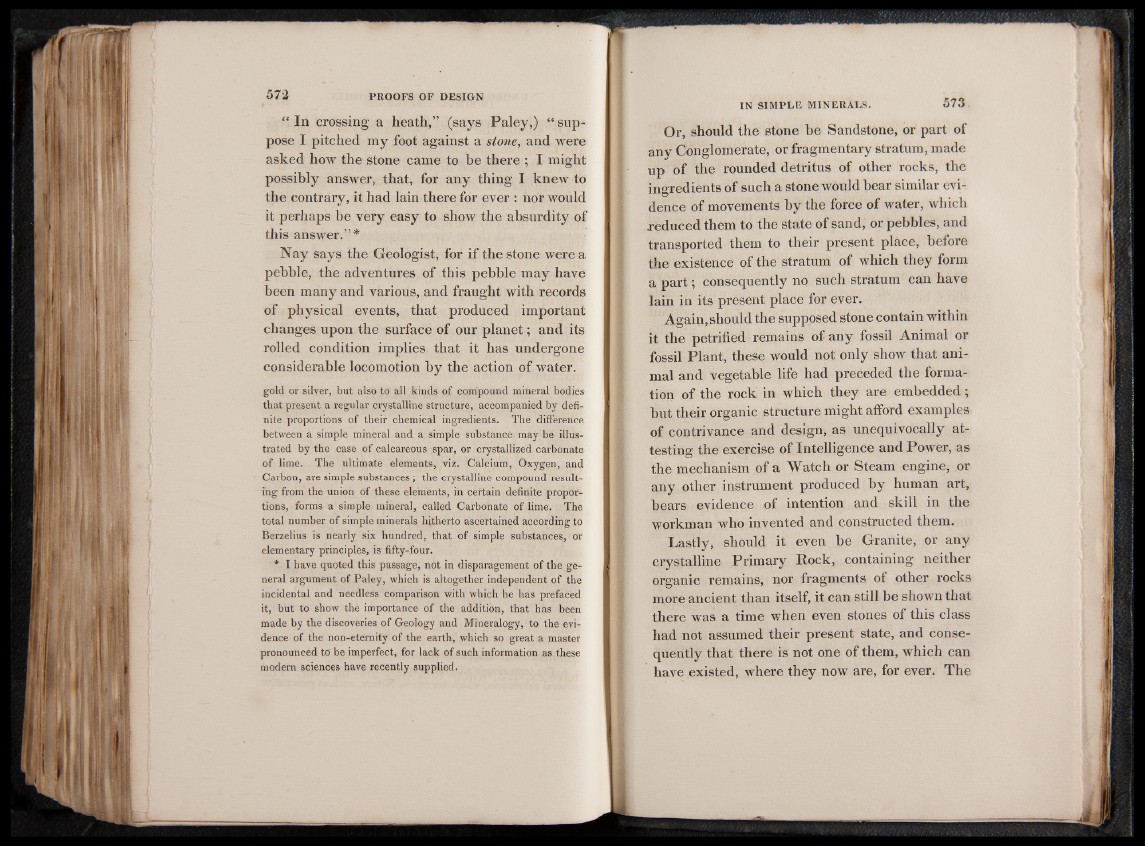
“ In crossing a heath,” (says P a ley ,) “ suppose
I pitched my foot against a stone, and were
asked how the stone came to be there ; I might
possibly answer, that, for any thing I knew to
the contrary, it had lain there for ever : nor would
it perhaps be very easy to show the absurdity of
this answer.” *
N a y says the Geologist, for i f the stone were a
pebble, the adventures o f this pebble may have
been many and various, and fraught with records
o f physical events, that produced important
changes upon the surface o f our p la n e t; and its
rolled condition implies that it has undergone
considerable locomotion b y the action o f water.
gold or silver, but also to all kinds of compound mineral bodies
that present a regular crystalline structure, accompanied by definite
proportions of their chemical ingredients. The difference
between a simple mineral and a simple substance may be illustrated
by the case of calcareous spar, or crystallized carbonate
of lime. The ultimate elements, viz. Calcium, Oxygen, and
Carbon, are simple substances ; the crystalline compound resulting
from the union of these elements, in certain definite proportions,
forms a simple mineral, called Carbonate of lime. The
total number of simple minerals hitherto ascertained according to
Berzelius is nearly six hundred, that of simple substances, or
elementary principles, is fifty-four.
* I have quoted this passage, not in disparagement of the general
argument of Paley, which is altogether independent of the
incidental and needless comparison with which he has prefaced
it, but to show the importance of the addition, that has been
made by the discoveries of Geology and Mineralogy, to the evidence
of the non-eternity of the earth, which so great a master
pronounced to be imperfect, for lack of such information as these
modern sciences have recently supplied.
Or, should the stone be Sandstone, or part of
any Conglomerate, or fragmentary stratum, made
up o f the rounded detritus of other rocks, the
ingredients o f such a stone would bear similar evi-
dence of movements b y the force o f water, which
reduced them to the state o f sand, or pebbles, and
transported them to their present place, before
the existence of the stratum of which they form
a part j consequently no such stratum can have
lain in its present place for ever.
Again, should the supposed stone contain within
it the petrified remains o f any fossil Animal or
fossil Plant, these would not only show that animal
and vegetable life had preceded the formation
o f the rock in which they are em bedd ed ;
but their organic structure might afford examples
of contrivance and design, as unequivocally attesting
the exercise o f Intelligence and Power, as
the mechanism o f a Watch or Steam engine, or
any other instrument produced by human art,
bears evidence of intention and skill in the
workman who invented and constructed them.
Lastly, should it even be Granite, or any
crystalline Primary Rock, containing neither
organic remains, nor fragments of other rocks
more ancient than itself, it can still be shown that
there was a time when even stones of this class
had not assumed their present state, and consequently
that there is not one o f them, which can
have existed, where they now are, for ever. The